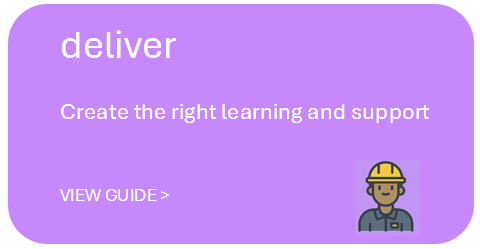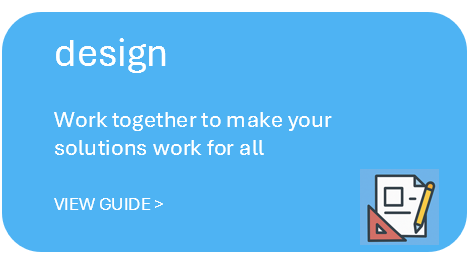Introduction
Delivery is where the apprenticeship becomes real. It’s where the learner enters the workplace, enrols in a qualification, and begins the challenging (and rewarding) journey of earning a degree while working.
This stage is not just about starting the programme. It’s about sustaining quality, coordination, and care across the full apprenticeship lifecycle.
DLAs succeed when:
Employers and providers are actively engaged in supporting the learner
Expectations are clear from day one
Learning is meaningfully embedded in the workplace
Academic and pastoral support are tailored to the work-based context
All partners communicate regularly and resolve issues quickly
This is not a “set and forget” stage, rather it’s an active partnership..
What this involves
The Delivery phase includes:
Recruiting and onboarding apprentices through dual-admissions processes
Inducting all parties, learner, employer, and provider, into the DLA model
Supporting the learner across both environments (academic, pastoral, cultural)
Facilitating workplace learning through supervision, coaching, and reflection
Monitoring progress and maintaining clear communication across partners
Resolving issues early before they impact learner success or programme quality
Now that the DLA has been designed, it’s time to deliver on its promise through clear coordination, shared responsibility, and learner-centred support
Employers
Your role: Provide the environment, supervision, and support for meaningful workplace learning—and stay actively engaged in the learner’s journey.
What to do:
Support the apprentice with onboarding and ongoing supervision: Make time to induct the apprentice into your workplace, team, and expectations and keep them supported throughout their journey.
Structure learning on the job: Align workplace activities with programme milestones (e.g. shadowing, projects, progression)
Stay connected: Participate in check-ins with the provider, review progress, and give feedback
Support wellbeing: Be alert to stress, fatigue, or external pressures—DLAs are a big commitment
Key outcome: A well-supported apprentice who contributes meaningfully to your organisation and grows into the role over time.
Tools for you
XXX
Tertiary providers
Your role: Deliver academic content, provide learner support, monitor progress, and maintain the integrity of the qualification, while working in partnership with the employer.
What to do
Enrol and onboard apprentices with clear expectations about their dual role as student and employee
Deliver flexibly: Ensure learning is accessible to people who are working—through online, hybrid, block-mode, or evening options
Monitor progress: Track academic achievement and engagement, and flag issues early
Coordinate support: Offer pastoral care, academic advice, and cultural connection tailored to employed learners
Engage with employers: Maintain regular communication to align learning and workplace development
Key outcome: Apprentices who progress academically, feel supported, and build the confidence to succeed in both study and work.
Tools for you
XXXX
Industry Skills Boards, Professional Bodies, and Industry Associations
Your role: Support delivery quality by maintaining occupational standards, encouraging good practice, and helping providers and employers address systemic barriers.
What to do
Share resources: Disseminate tools, templates, or frameworks that help standardise good practice
Spot barriers: Listen for issues that arise during delivery and help identify policy or structural workarounds
Celebrate progress: Share stories of success and progress to inspire other employers or sectors
Facilitate learning: Encourage peer learning through sector-wide workshops and networks, and keep apprentices connected with professional registration processes
Support employers: Connect employers to capability development opportunities
Maintain industry alignment: Ensure the DLA stays relevant to emerging sector needs or registration pathways
Key outcome: Confidence that the DLA will produce competent, recognised, and employable graduates within the profession or industry.
Tools for you
XXXX
Learners and Whānau
Your role: Step fully into the dual identity of employee and learner—knowing that support is available and that your success is a shared responsibility.
What to do:
Navigate two systems: You’ll be working and studying sometimes with overlapping pressures.
Clear support channels: Know who to talk to at work and at your provider when issues come up.
Time management: You’ll need to plan your weeks carefully and advocate for yourself when workloads grow.
Progress milestones: You’ll get feedback from both work and study to guide your development.
Celebration and growth: You’ll develop faster than you think professionally and personally.
Key outcome: A strong sense of belonging, progress, and confidence as you move through the apprenticeship.
Tools for you
XXXXX
Tools and Templates
You can use the following tools (available in the toolkit) to support alignment conversations:
XXXXX
What comes next?
Once the DLA is underway, the focus turns to monitoring outcomes, improving practice, and planning for future delivery or scale. This moves naturally into the Sustain phase.
But delivery isn’t just a step between design and evaluation. It’s where the value of the partnership becomes visible. It’s where learners grow, workplaces benefit, and the system learns what works.
The DLA toolkit
Guidelines
-

Guide for employers
An introduction to degree-level apprenticeships for employers
-

Guide for apprentices
An introduction to degree-level apprenticeships for learners
-

Guide for TEOs
An introduction to degree-level apprenticeships for tertiary education organisations











